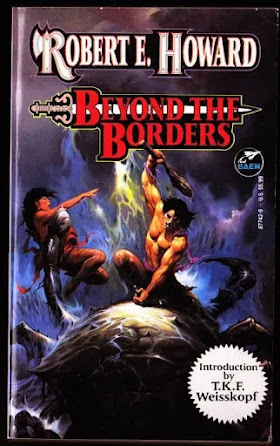I meant to make a post on this a few months back.
Roy Thomas's return to Conan happened a while back, and, as other fans are saying, it was well worth the wait. The issue of Savage Sword was #7, with lead story "Mark of the drawn the Beast, " drawn by Roberto de La Torre. This is De La Torre's first time on a lead feature for SSOC. The story is a "Conanization"of a short horror tale penned by Rudyad Kipling. From my research, and rather surprisingly, Kipling's original taale features a regular old werewolf, and not a weretiger as does Thomas's take on it. There story is also a sequal of sorts to Thomas's adaptation of "Moon of Zembabwei," a classic Howard horror story, but not Conan tale, as was the case with a lot of other adaptations of Howard non-concn tales that got adapted back in the Marvel years.
The current tale starts with Conan returning Helga, the beautiful slave girl from that tale to her father in Nemedia. After this, Conan meets a fellow named Raja, who becomes infected by a grotwsque "silver man" who seems infected by a type of leprosy. Later, Raja mysteriously, and Conan encounters the Mark of Jhebbal Sag, first mentioned by inb "Beyond the Black River", a symbol known by Pictish shamans to summon the beasts of the forest. It is also used by the sorcerer D'jegga the beat king, and is recognized by certain animal species, such as leopards, hyenas, pythons, crocodiles and birds of prey from the anceint time when beasts and men spoke the same tongue.

Afterward, Conan encounters Dharahini, a beautiful and uber-sexy priestess of Jhebbal-Sag, who commands hords of leopards, wolves, pythons, hawks, and komodo dragons. She takes a liking to our Cimmerian hero, and Conan naturally obliges. But he rebels once he learns of her plans to conquer humanity and it's then that Dharini dummons forth Raja, now transformed into a were-tiger, now under her thrall. Conan triumphs of coiurse, after talking some sense back into Raja, even while under Dharini's spell. He then must take on her legions of beasts, during which Dharini is killed during the battle, and that about wraps up the lead feature. As others have comments, this could easily have been passed off as one of the better issues in classic '70s run of Thomas, drawn by Buscema. Yes, it's really that good!
All-in-all, its a fantastic issume. But there is one draw-back. Not of the issue itself, but the very apparent news that Roy Thomas is not here for a lengthy stay, as I had first assumed. No, this issue is a one shot for him. That's not to say he won't nesessarily be back for furture issues; only that he's not back as a regular writer.
Looking forward to future SSOC issues featuring Doug Braithwraite's art, as he did a fantatic job on Conan's recetn adventure where he re-nconters Zula, the Darfaran warrior of the early seventies Marvel issues--not be be confused with the female warrior Conan the Destroyer--though she has as a quai-cameo in that story as well.












